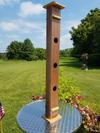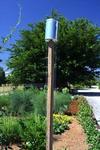- Home
- FUN & Forums
- Aeolian Harp Plans
Aeolian Harp Plans
Have fun experimenting with the following Aeolian Harp plans. Wind harps, sometimes called window harps, became quite popular in England and throughout Europe in the early 1800s, and they were even reflected in the English poetry of that time.
An ethereal, alien-like musical sound is produced whenever a gust of wind or light breeze blows over the harp's strings causing them to vibrate without human assistance. Discover how you can make your own window harp for years of listening enjoyment.
How to Build an Aeolian Harp
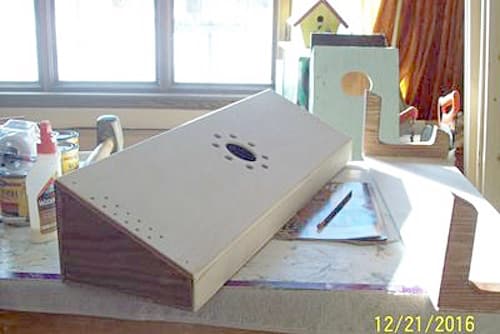 Why Not Build a Homemade Aeolian Harp?
Why Not Build a Homemade Aeolian Harp?(Source: Submitted by Richard Wilts)
Wind harps are truly a conversation piece and relaxing to the ear, and I hope that the simple plans given below will get you started on building one of your own.
A window harp can be custom made to fit within a modern sliding window, whether horizontal or vertical, to provide any room with soothing background melodies as demonstrated in the YouTube video below.

The gentleman in the following YouTube video clearly shows how to build a modern wind harp using a piece of common gutter downspout. The type of tuning pins and strings he used is also discussed.

Wind Harp Strings and Tuning
Aeolian Harp Tuning Tip
Some wind harp makers suggest using nylon guitar strings, perhaps 4 Gs, 4 Bs, and 4 Es, all 12 strings tuned to the same note, often a low G.
They can be attached to headless nails at one end, and tuning pins similar to those used in auto-harps at the other. Most music stores should stock or be able to order the strings and pins you need.
The above video addresses the often asked question, "What kind of pins and strings are used for stringing Aeolian harps?"
When it comes to tuning pins, zither tuning pins work well; they have about an inch of thread at one end and a square head at the other end to fit a tuning key, with a small hole to secure the string.
The pins can be securely screwed into an 11/64th-inch drilled hole at one end of the harp. Brad nails of a suitable size can be carefully driven into the wood at the harp's other end to serve as pitching pins.
The strings used must be "round" to be effective in the wind. Round weed whacker string from the hardware store can be used for large outdoor harps, while 25-pound test nylon fishing line (20 thousandths of an inch thick, approx. 50 mm) works well for small instruments.
Old nylon guitar strings work well, but you are limited to a 30-32 inch instrument length. Harp string works great, but it's often only sold in rolls of 50 feet at stores that sell parts for musical instruments and can get expensive.
Don't over worry about proper tuning, as who can say what an Aeolian harp should truly sound like. Tune to your preference, and an out-of-tune harp often sounds just fine. Above all, experiment.
DIY Aeolian Harp Plans
The website of Aeolian instrument enthusiast Uli Whal presents a large collection of Aeolian articles and information in both English and German languages. Being an older-style website, it does require some exploration to locate the detailed information wanted; however, it's well worth the effort.
There's an extensive collection of wind generated sounds you can listen to in MP3 format. Aside from the musical sounds produced by an assortment of Aeolian harps, you'll be amazed when hearing the ethereal sounds created by the blowing wind on power transmission lines, telephone poles, kite musical instruments, kite lines, wind harmonicas, and even a Portuguese windmill near Lisbon.
Of special interest to Aeolian fans is Whal's detailed instruction and examples of how his recordings were made. Plus, he describes how to build and use a simple yet effective tin can resonator for amplifying the wind sound that's similar to the string telephones we made as children.
Whal also describes how to make a contact microphone to transfer Aeolian sounds to the input on a recording device using a simple piezo electric disc.
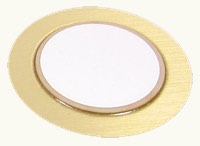 Piezo Electric Disc
Piezo Electric DiscPiezo discs (disks) can be purchased at most music stores, or they can be easily bought online from Amazon, and they cost very little. They are used by hobbyists for installing in cigar box guitars and homemade musical instruments; however, they are perfect for use with Aeolian harps and the capturing of most wind-generated sounds.
Instructions for using piezo discs as a simple contact microphone are given online, courtesy of Richard Lerman, Arizona State University West.
Here's an interesting YouTube video of a freestanding gutter harp in action. It gives you an idea of the possible musical sounds a wind harp can generate.

Contemporary Aeolian Harp Plans
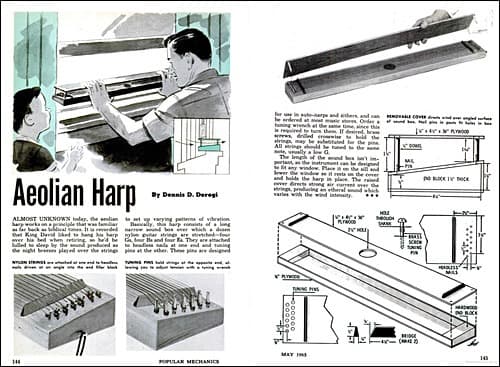 Aeolian Harp Plans in Popular Mechanics May 1965 Edition
Aeolian Harp Plans in Popular Mechanics May 1965 Edition(Source: Popular Mechanics Magazine)
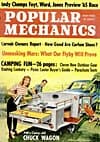
Popular Mechanics magazine's May 1965 edition contains an excellent article that features Aeolian Harp plans by Dennis D. Dorogi. The article is complete with detailed photos, illustrations, material measurements, and assembling instructions to make a wind harp designed to fit any window size.
The article describes the finished Aeolian harp's operation saying, "The raised cover directs strong air current over the strings, producing an ethereal sound which varies with the wind intensity."
Although I cannot display the information on this page because of its copyright restrictions (© 1965 Hearst Corporation), a PDF copy of the Popular Mechanics May 1965 edition can be downloaded from Internet Archive website. Enjoy.
Traditional Aeolian Harp Plans
Popular Science Monthly (August, 1921)
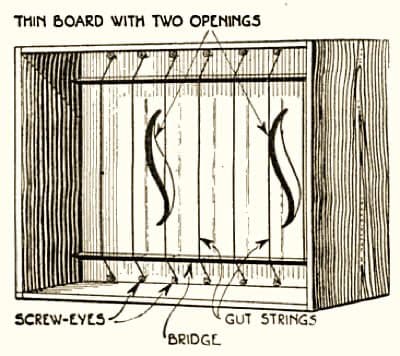 Aeolian Harp Plans
Aeolian Harp Plans(PD Source: Popular Science Monthly)
These are rather pleasant things in the summer, as when the wind blows, they murmur and hum and sing. Aeolian harp plans are sometimes very simple.
If you wish to make an Aeolian harp, first decide where you will have it, whether in the open window, in place of one of the panes, or in a fanlight or ventilator opening; any opening that the wind has access to will do.
Then make a wooden frame to fit the opening. Make it fairly stiff with a top and bottom of hardwood; onto this frame glue a very thin sheet of wood having two openings in it, similar to those in a violin. This thin sheet must be flush with the outside of the window, so that the frame projects into the room.
It is recommended that a screen is fastened behind the two openings to prevent unwanted insects from entering the room.
Now, get some screw-eyes and screw them halfway into the top and bottom of the frame, close to the back. The number used is a matter of taste; the more strings there are, the louder the harp.
To these screw-eyes, stretch gut strings, similar to those used for violins and banjos. Fasten them tightly and put two bridges under them of sufficient height so that the strain comes on the bridges, then screw up the eyes until you have sufficient tension; the tighter the strings the higher the note; they may be of various tensions or tuned to one note.
The wind and an Aeolian harp will entertain you with a continuous musical performance. —E. A. McCann, Popular Science Monthly
Victorian Aeolian Harp Plans
Knights American Mechanical Dictionary (1877)
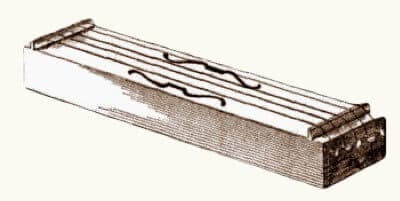 Traditional Aeolian Window Harp Design
Traditional Aeolian Window Harp Design(PD Source: Knights Amerian Mechanical Dictionary, 1877)
A common mode of construction is to make a box of thin wood and of suitable length, to set beneath a window sash. It may be five or six inches in width and depth.
At one end of the box are pins equal in number to the strings employed, and at the other as many pegs; the strings, being made fast to the pins at one end, are tuned by turning the pegs at the other.
The box is open on the sides presented towards the room and to the exterior air, and the strings are sounded by the passage of the air over the box. Catgut is usually employed for the strings.
It is supposed to have been invented by John J. Schnell, musical instrument maker to the Countess d'Artois. It was suggested by the vibration of the strings of a harp placed in a breezy situation. It was exposed for sale in 1789, under the name of Anemo Chorde. Its use was revived by Kircher.
What Is an Aeolian Harp?
A species of musical instrument, the sounds of which are produced by currents of air passing over its strings, commonly fifteen in number. Its principle may be familiarly shown on a large scale by the action of the telegraph wires stretched from one pole to another.
On a windy day especially these will be found, by anyone stationed near, to emit low musical tones rising and falling in proportion to the strength of the wind, and more or less silent in proportion to the tension of the wires. Were the number of wires increased, and their length and tension properly varied, these would constitute a perfect Aeolian.
The Babylonian Talmud says that the harp of David sounded when the north wind blew on it, and it has been suggested that he had an Aeolian, as we understand it.
The sounding of his harp by a gust of wind would be nothing extraordinary if it stood near his north window, which was probably open for air and chosen for its coolness and shade in the climate of Judaea.
Aeolian Window Harp Plans
The Household Cyclopedia of General Information (1881)
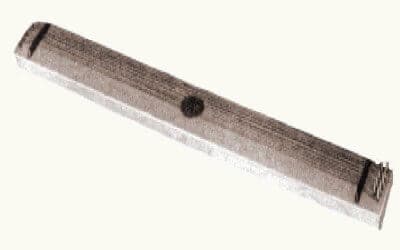 Aeolian Wind Harp
Aeolian Wind Harp(PD Source: The Household Cyclopedia, 1881)
Aeolian harp plans: Of very thin cedar, pine, or other soft woods make a box 5 or 6 inches deep, 7 or 8 inches wide, and of a length just equal to the width of the window sill in which it is to be placed.
Across the top, near each end, glue a strip of wood half an inch high and a quarter of an inch thick, for bridges.
Into the ends of the box insert wooden pins, like those of a violin, to wind the strings around, two pins in each end.
Make a sound-hole in the middle of the top, and string the box with small cat gut, or blue first-fiddle strings. Fastening one end of each string to a metallic pin in one end of the box, and, carrying it over the bridges, wind it around the turning-pin in the opposite end of the box.
The ends of the box should be increased in thickness where the wooden pins enter, by a piece of wood glued upon the inside.
Tune the strings in unison and place the box in the window. It is better to have four strings, as described, but a harp with a single string produces an exceedingly sweet melody of notes, which vary with the force of the wind.
Unintentional Wind Harps
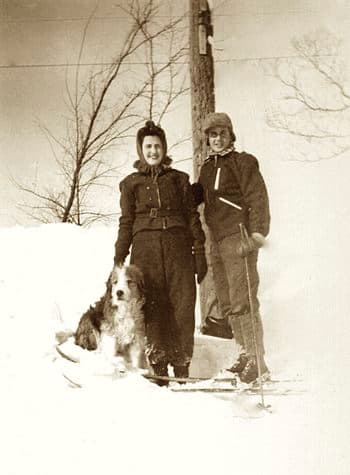 Singing Telphone Wires In the 1940s
Singing Telphone Wires In the 1940s(Source: Don Bell)
Did you know that Aeolian wind harps can be unintentionally created by transmission lines, guide wires, telephone poles, and wire-strung fences?
Sometimes, on a windy day, musical tones can be heard rising and falling in proportion to the strength of the wind and generally in proportion to the tension of the wires.
As a young boy walking to school "in the good old days," I loved the cool, crisp winter mornings when the roadside telephone wires hummed their eerie tunes.
Each telephone pole gave its own distinctive sound, when you pressed your ear against the wooden pole. It was magical to hear them "singing."
Aeolian Harps Built by Others
 Aeolian Harp Pergola
Aeolian Harp Pergola(Source: ©123rf.com/youry-ermoshkin)
The Pergola Aeolian Harp
Wind harps come in all shapes, sizes, and designs. For instance, the remnant of a unique Aeolian harp stands on a mountain slope overlooking the popular spa city of Pyatigorsk, Russia, in the northern foothills of the Caucasus Mountains.
The small stone pergola (shown above) was built in 1822, and it originally had two handcrafted wooden harps embedded in its floor. As the wind turned the weathercock on the dome, it activated a geared mechanism that touched the strings to create pleasing musical sounds.
It is said that wind harps have ancient roots going back to the time of Israel's King David, when harps were hung on tree branches to catch the evening breezes.
Nowadays, when placed on a balcony, patio railing, or window sill, the melodious, relaxing sound generated by a window harp offers a pleasing alternative to wind chimes.
The Water Jug Harp
The short YouTube video below features an Aeolian Harp that uses a common 3-gallon water jug as its resonance chamber. The modified jug is suspended between two poles on 100-pound Dyneema cord. Listen to its uniquely alien-like sounds.

Click Here to read about the various aeolian harp plans favored by other visitors to this site. You are sure to find inspiration for creating your own wind harp design.
The Aeolian Wind Harp in Poetry
The following poem written by Samuel Taylor Coleridge descriptively captures the ethereal sound of the wind-generated notes.
The AEolian Harp
And that simplest Lute,
Placed length-ways in the clasping casement, hark!
How by the desultory breeze caressed,
Like some coy maid half yielding to her lover,
It pours such sweet upbraiding, as must needs
Tempt to repeat the wrong! And now, its strings
Boldlier swept, the long sequacious notes
Over delicious surges sink and rise,
Such a soft floating witchery of sound
As twilight Elfins make, when they at eve
Voyage on gentle gales from Fairy-Land,
Where Melodies round honey-dropping flowers,
Footless and wild, like birds of Paradise,
Nor pause, nor perch, hovering on untamed wing!
—Excerpt from a poem by Samuel Taylor Coleridge (1772-1834), composed at his cottage in Clevedon, Somersetshire, in 1795.
Have You Made an Aeolian Harp?
Please tell us about your Aeolian harp. Share the story of how you made it, where you placed it, what it sounds like, and so on.
Your story automatically becomes its own Web Page, so include at least 400 words of text and photos, so it can get accepted by the search engines. When published, it becomes available to you, your friends, and other visitors to this site.
Harp Stories Others Have Shared
Click on the links below to see Aeolian Harp stories shared by other visitors, and the comments they received.
Downspout 10 String Wind Harp
I watched the video on making an Aeolian downspout harp and proceeded to create one: a 3x4-inch, 3 foot long, 10 string, 2 sided wind harp. I thought it …
Aeolian Harps by Kevin Andrew Busse
The Evolution of Aeolian Harps Built by Kevin Busse. Humble Beginnings: Summer 2014. (See Aeolian Harp Photo 1).
The first 3 Aeolian harps I built are …
Richard Wilts 1st Aeolian Harp
I saw a picture of an Aeolian Harp in an old 1956 handyman book and decided to make one. I tried to find 1/8" thick wood that was at least 7" wide but …
Simple Is the Key to Success
Last spring, I built a simple Aeolian Harp, a basic 3/8-inch pine box with an 1/8-inch plywood top and bottom to fit horizontally across the width of my …
My Homemade Gutter Harps
I made three wind harps out of old gutter pieces I had in a scrap pile: one 36 inch, one 24 inch, and one 12 inch. I didn't use tuning screws, instead …
The Ugly Stick Harp
This is my second Aeolian Harp, the first ones were plastic soda bottles with slits cut in the sides, and about 30 feet of curling ribbon tied between …
Aeolian Harps & Singing Telephone Poles
Apparently, any box with a hole and with strings over it will act as an Aeolian harp. So, if you have the right location and pull out a guitar or violin …
How to Share Your Story

Why not share your story? It's easy and fun to do, and we would all love to read it. Click the Button below for easy instructions.
Join Grandma's Dessert Club Today and…

Download your FREE COPY of Grandma McIlmoyle's Little Dessert Book. Also receive regular club Bulletins with delicious recipes straight to your inbox, and more.
My special Gift to you!
"Love your Grandma's Dessert Club Bulletins! I look forward to each issue." —Sharon, USA

